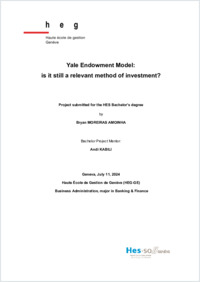Yale endowment model : is it still a relevant method of investment?
SONAR|HES-SO
- Moreiras Amoinha, Bryan
- Kabili, Andi (Degree supervisor)
- Genève : Haute école de gestion de Genève
113 p.
Bachelor of Science HES-SO en Economie d’entreprise: Haute école de gestion de Genève, 2024
English
Under David F. Swensen’s influence, Yale’s endowment pioneered a shift from traditional marketable securities to non-traditional asset classes. This innovative strategy led to remarkable long-term returns, setting a high standard in the investment community. However, recent performance has been criticized for being underwhelming compared to past achievements and current market returns. Therefore, this Bachelor’s thesis aims to evaluate the relevance of the Yale Endowment Model in today’s landscape.
From 1990 to 2023, Yale’s endowment demonstrated excellent performance. A significant portion of its returns has been independent of its benchmark, and despite higher volatility, Yale’s endowment consistently achieved superior risk-adjusted returns compared to its environment and the traditional “60/40” asset allocation. Financial metrics indicate that Yale employs a diversified strategy, including non-market-correlated investments and active management. Based on quantitative analysis, Yale’s significant outperformance relative to its peers and traditional asset allocations was primarily achieved from 2000 to 2008. Since then, Yale has faced challenges in generating excess returns through its asset allocation, which is heavily weighted toward alternative investments. This trend calls into question the ongoing relevance of Yale’s asset allocation and investment strategies.
Yale’s outperformance is fundamentally tied to four distinct elements: the investment strategy, the expertise of the Yale Investments Office, the network of relationships, and the early-mover advantage. These successes are also due to the clarity of Yale’s spending and investment policies and the unique traits of the endowment, such as its long-term investment horizon and tax status. However, the bull market in U.S. equity following the Great Recession and the decline in returns of alternative asset classes since then could explain this decrease in outperformance. Despite these challenges, Yale’s endowment still outperforms its environment and traditional portfolios, though its risk-adjusted return is lower compared to the “60/40” U.S. portfolio model.
The relevance of the Yale Endowment Model today is complex. For Yale University, David F. Swensen’s approach remains highly effective due to its unique resources, pragmatic strategy, and long-term focus. However, replication by other endowments or institutional investors is challenging without the same circumstances and resources required for its success. Therefore, strictly adhering to the Yale Model can significantly impact performance, potentially jeopardizing the investor’s objectives. Its replication by other endowments or investors should be approached with cautiousness.
From 1990 to 2023, Yale’s endowment demonstrated excellent performance. A significant portion of its returns has been independent of its benchmark, and despite higher volatility, Yale’s endowment consistently achieved superior risk-adjusted returns compared to its environment and the traditional “60/40” asset allocation. Financial metrics indicate that Yale employs a diversified strategy, including non-market-correlated investments and active management. Based on quantitative analysis, Yale’s significant outperformance relative to its peers and traditional asset allocations was primarily achieved from 2000 to 2008. Since then, Yale has faced challenges in generating excess returns through its asset allocation, which is heavily weighted toward alternative investments. This trend calls into question the ongoing relevance of Yale’s asset allocation and investment strategies.
Yale’s outperformance is fundamentally tied to four distinct elements: the investment strategy, the expertise of the Yale Investments Office, the network of relationships, and the early-mover advantage. These successes are also due to the clarity of Yale’s spending and investment policies and the unique traits of the endowment, such as its long-term investment horizon and tax status. However, the bull market in U.S. equity following the Great Recession and the decline in returns of alternative asset classes since then could explain this decrease in outperformance. Despite these challenges, Yale’s endowment still outperforms its environment and traditional portfolios, though its risk-adjusted return is lower compared to the “60/40” U.S. portfolio model.
The relevance of the Yale Endowment Model today is complex. For Yale University, David F. Swensen’s approach remains highly effective due to its unique resources, pragmatic strategy, and long-term focus. However, replication by other endowments or institutional investors is challenging without the same circumstances and resources required for its success. Therefore, strictly adhering to the Yale Model can significantly impact performance, potentially jeopardizing the investor’s objectives. Its replication by other endowments or investors should be approached with cautiousness.
- Language
-
- French
- Classification
- Economics
- Notes
-
- Haute école de gestion Genève
- Economie d’entreprise
- hesso:hegge
- Persistent URL
- https://sonar.ch/global/documents/331329
Statistics
Document views: 33
File downloads:
- MOREIRAS AMOINHA-BRYAN-RENDU-JUL.pdf: 97
